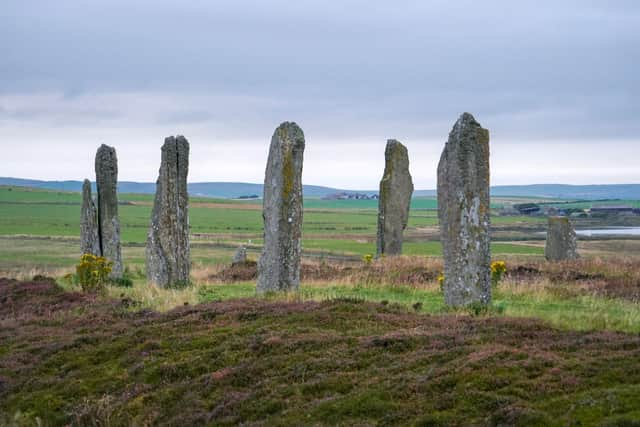Summer Solstice Scotland: The ancient traditions marking the longest day
For thousands of years in Scotland, the Summer Solstice, or the longest day when the sun appears to stand still as it barely dips from the sky, has been celebrated.
The Clanais Stones in Lewis are set to have an astronomical alignment to sunrise on the Summer Solstice, with the Barnstone in Orkney also believed to have a special place at this time of year.
Advertisement
Hide AdAdvertisement
Hide AdTraces of solstice celebration and ritual are chiefly found found across Orkney and Shetland, where Scandinavian influences are the strongest and daylight spans almost 18 hours a day at this time of year.


Marian McNeill, in her seminal work The Silver Bough II, wrote: “The Midsummer sun was associated by our Scandinavian forefathers with Baldur, the god of light – the most beautiful, the most virtuous, the best beloved of all the gods; for the summer solstice, when the days began to shorten and the rule of light was threatened by the encroaching powers of darkness, marked the anniversary of his death and his descent from Asgard into the lower world.”
Celebrations were also common in the North East of Scotland where midsummer fires, which although druid in origin, were later lit to mark Midsummer's Day, or St John's Day on June 24. They blazed on coastlines and hills, with the celebrations held in great affection by the people who regarded them as sources of good fellowship and positive atmosphere.
The Kirk, post reformation, tried to ban these fires, which were judged to be superstitious, but the tradition held firm for hundreds of years.
Herbs used for medicine and ritual were believed to have been at their most potent at midsummer, as was the prospect of love and the pairing of sweethearts on nights when the special light of late June, known in the far north as the Simmer Dim, barely fades.
In Orkney, until recent times, a couple of hundred people would gather at the Ring of Brodgar, the stone circle and ceremonial site which dates back to the third millennium BC, for Summer Solstice, but organised celebrations have given way to more individual acts of observance given the fragility of the site.
Helen Woodsford-Dean, of Spiritual Orkney, who previously ran solstice events at Ring of Brodgar, with her husband Mark, said: “Many Pagans, and other people of faith and of no faith celebrate the midsummer solstice.
“We celebrate the power or light and warmth and summer and honour the mystery of how every zenith contains its nadir, and every nadir its zenith. At the solstice, the sun seems to stand still, rising and setting in the same place in the landscape for several days.
Advertisement
Hide AdAdvertisement
Hide Ad“As this time of year is associated with the sun and light, we will probably both take a few moments to think about the sun and to visualise golden light pouring down onto, into and over us.
“We will ask for the light of the inner sun to shine on our paths and for the source of all life to bless us, our families, our peoples and our lands.”
“We give thanks to the sun for is blessings of light and of light and for the beauty and passion that it is all life.
Orkney has held the observance of summer solstice long and close. In the mid-19th century, a “curious relic of sun-worship” was discovered in a cist between two standing stones in the parish of Harray. Four ornamented discs of thin gold, each about three inches in diameter, with a hole pierced through the centre, were found.
“It is believed that these discs were placed in a chariot that represented the fiery chariot in which the sun-god Frey drove across the heavens on his daily course,” Ms McNeill wrote.
Over in Lewis, the Calanis Stones have also been central to solstice celebrations for possibly thousands of years although now the vulnerability of the ancient site, which has been damaged by erosion, means that gatherings are now potentially harmful.
Dr Alison Sheridan, board member of Urras nan Tursachan, said there were several astronomical orientations marked by the Calanais stones, with one aligning to the sunrise on the morning of midsummer solstice.
“Of course, we don't know what ceremonies took place after the circle was built around 2,900BC,” she said.
Advertisement
Hide AdAdvertisement
Hide AdAccording to Ms McNeill, herbs gathered on Midsummer Eve were commonly used for both occult and medicinal purposes.
St John's Wort, which today is used by some people who suffer low mood and depression, is said to be named after St John's Day, or Midsummer's Day.
“In many districts, St John's Wort, when gathered on St John's Eve (when all simples were believed to be more potent) was hung on house and farm buildings to protect against thunder and evil spirits,” Ms McNeill wrote. “It was also burned in the midsummer fires for magical purposes. In Aberdeenshire, it was said that if one slept with the plan under one's pillow, the saint would appear in a dream and give the sleeper his blessing.”
In the Highlands and Hebrides, St John's Wort was long considered to be linked to second sight, and enchantment and was placed in the house to ensure peace and plenty. Meanwhile, fern seed collected on Midsummer's Eve was believed to possess great powers of protection.
Comments
Want to join the conversation? Please or to comment on this article.